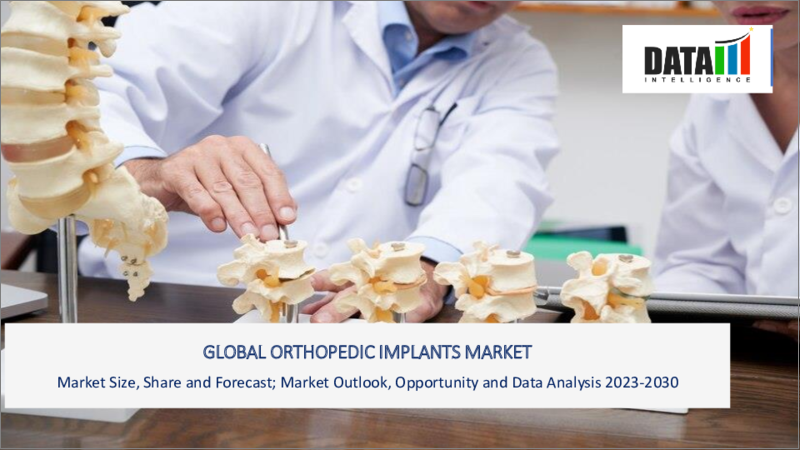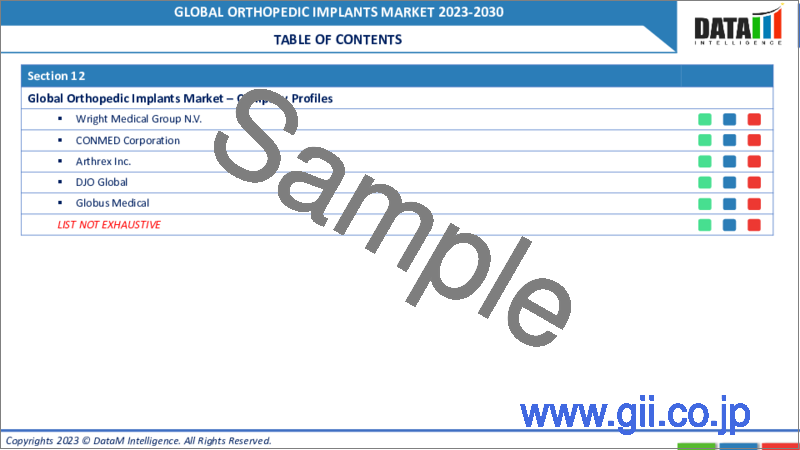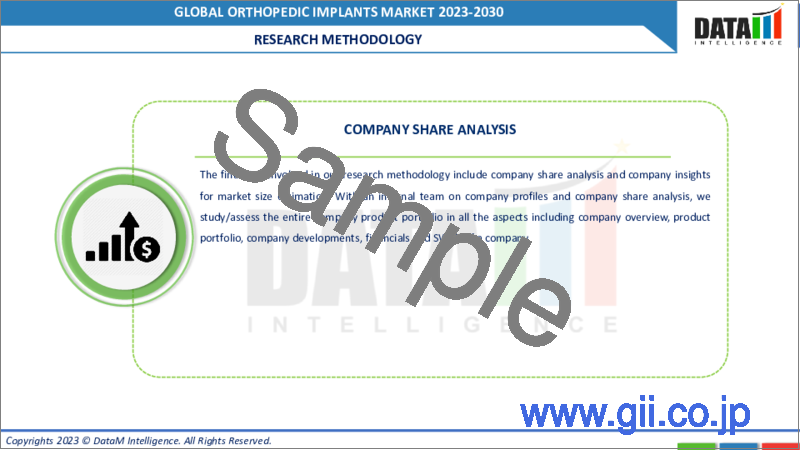|
|
市場調査レポート
商品コード
1297779
整形外科用インプラントの世界市場-2023年~2030年Global Orthopedic Implants Market - 2023-2030 |
||||||
カスタマイズ可能
適宜更新あり
|
|||||||
| 整形外科用インプラントの世界市場-2023年~2030年 |
|
出版日: 2023年06月15日
発行: DataM Intelligence
ページ情報: 英文 195 Pages
納期: 即日から翌営業日
|
- 全表示
- 概要
- 目次
市場概要
整形外科用インプラントの世界市場規模は、2022年に447億米ドルに達し、2030年には716億米ドルまで成長すると予測されています。予測期間2023-2030年のCAGRは6.2%です。
整形外科用インプラントは、毒性、細胞毒性、感作性の面で生物学的に評価された様々な生体材料から開発されています。コーティング、合金化、酸化防止などの材料強化技術は、インプラント材料の耐食性と不活性を高めるために使用されます。
骨損傷治療におけるインプラントの生物学的、臨床的、さらには生体力学的な利点を高めるために、インプラントを骨組織に統合することが現在注目されています。
市場力学
筋骨格系障害の有病率の増加
骨折、変形性関節症、骨粗鬆症などの筋骨格系障害の有病率の増加は、整形外科用インプラント市場シェアを牽引する主要因です。筋骨格系障害は、人口の高齢化、座りっぱなしのライフスタイル、慢性疾患の増加により、世界的に蔓延しつつあります。これらの障害には、関節置換、骨折固定、脊椎安定化のための外科的介入や整形外科用インプラントが必要とされることが多いです。
筋骨格系障害の有病率が上昇を続ける中、可動性を回復し、痛みを和らげ、罹患者の生活の質を向上させる整形外科用インプラントに対する需要が高まっています。このような整形外科用インプラントの需要増加が市場シェアの拡大に寄与しています。
例えば、2023年4月、グローバス・メディカル(Globus Medical)は、ヘルスケア・ソリューションの開発と商品化を行う医療機器企業であり、筋骨格系障害を持つ患者の生活の質を向上させることを使命としています。グローバスは、医療機器の革新に尽力し、病院、外来手術センター、医師に卓越したサービスを提供することで、患者ケアの向上と効率化を図っています。
整形外科用インプラントの高コスト
整形外科用インプラントの高コストは、予測期間中の市場シェアを妨げます。整形外科用インプラントの高額なコストは、特にヘルスケア資源が限られている地域や保険適用が不十分な地域では、多くの患者にとって手が届かないものとなる可能性があります。その結果、手術が遅れたり延期されたり、別の治療法が検討されたりする可能性があります。
ヘルスケアのインフラやリソースが限られている発展途上諸国では、整形外科用インプラントの高額な費用が大きな障壁となる可能性があります。これは、先進的なインプラント技術の採用を妨げ、質の高い整形外科医療へのアクセスを制限する可能性があります。
COVID-19影響分析
COVID-19パンデミックは整形外科用インプラント市場に大きな影響を与えました。パンデミックの間、対面診療を最小限に抑え、ウイルス感染のリスクを減らすため、遠隔医療や遠隔診療へのシフトが顕著でした。しかし、整形外科手術では通常、対面での評価や処置が必要であり、この分野での遠隔医療の範囲は限定されています。
パンデミックによる景気後退とCOVID-19対応へのヘルスケア支出の増加は、ヘルスケア予算を圧迫しました。病院やヘルスケア施設は財政難に直面し、整形外科用インプラントや関連処置への投資の減少につながる可能性があっています。
ロシア・ウクライナ紛争分析
ロシアとウクライナの紛争は、世界の整形外科用インプラント市場に大きな影響を与えています。紛争は政治的不安定をもたらし、不確実性を生み出し、貿易関係を混乱させています。一部の国による政治的緊張や制裁措置は、整形外科用インプラントの輸出入に影響を及ぼし、サプライチェーンの混乱や市場の不確実性につながる可能性があります。
紛争は、ヘルスケア・プロバイダーが整形外科用インプラント技術の最新の進歩にアクセスすることを制限する可能性があります。国際的な協力、調査、最先端のインプラント技術へのアクセスが妨げられ、新しいインプラント技術の革新や採用が遅れる可能性があります。
目次
第1章 調査手法と範囲
第2章 定義と概要
第3章 エグゼクティブサマリー
第4章 市場力学
- 影響を与える要因
- 促進要因
- 筋骨格系疾患の有病率の増加
- 抑制要因
- 整形外科用インプラントは高額
- 機会
- 影響分析
- 促進要因
第5章 業界分析
- ポーターのファイブフォース分析
- サプライチェーン分析
- 価格分析
- 規制分析
第6章 COVID-19の分析
第7章 製品別
- 再建的関節置換術
- 脊椎インプラント
- 歯科インプラント
- オーソバイオロジクス
- 頭蓋顎顔面
- その他
第8章 素材別
- セラミックス
- 高分子材料
- 天然素材
第9章 エンドユーザー別
- 病院
- 整形外科クリニック
- ホームケア
- その他
第10章 地域別
- 北米
- 米国
- カナダ
- メキシコ
- 欧州
- ドイツ
- 英国
- フランス
- イタリア
- スペイン
- その他欧州
- 南米
- ブラジル
- アルゼンチン
- その他南米
- アジア太平洋
- 中国
- インド
- 日本
- オーストラリア
- その他アジア太平洋地域
- 中東とアフリカ
第11章 競合情勢
- 競合シナリオ
- 市場ポジショニング/シェア分析
- 合併と買収の分析
第12章 企業プロファイル
- Johnson &Johnson
- 会社概要
- 製品ポートフォリオと説明
- 財務概要
- 主な発展
- Zimmer Biomet
- Stryker Corporation
- Medtronic Plc
- Smith and Nephew Plc
- Wright Medical Group NV
- CONMED Corporation
- Arthrex Inc.
- DJO Global
- Globus Medical
第13章 付録
Market Overview
The Global Orthopaedic Implants market size reached US$ 44.7 billion in 2022 and is projected to witness lucrative growth by reaching up to US$ 71.6 billion by 2030. The market is exhibiting at a CAGR of 6.2% during the forecast period 2023-2030.
Orthopedic implants have been developed from various biomaterials biologically evaluated in aspects of toxicity, cytotoxicity, and sensitization. Material enhancement techniques such as coating, alloying, and antioxidation are used to increase the corrosion resistance and inertness of the implant materials.
Integration of the implant into the bone tissue is currently under interest to enhance the biological, clinical, and even biomechanical benefits of the implants in the treatment of bone injuries.
Market Dynamics
Increasing prevalence of musculoskeletal disorders
The increasing prevalence of musculoskeletal disorders such as bone fractures, osteoarthritis, and osteoporosis is the major factor driving the orthopedic implants market share. Musculoskeletal disorders are becoming more prevalent globally due to aging populations, sedentary lifestyles, and increased chronic conditions. These disorders often require surgical intervention and orthopedic implants for joint replacements, fracture fixation, and spinal stabilization.
As the prevalence of musculoskeletal disorders continues to rise, there is a growing demand for orthopedic implants to restore mobility, alleviate pain, and improve the quality of life for affected individuals. This increased demand for orthopedic implants contributes to the growth of the market share.
For instance, in April 2023, Globus Medical, a medical device company that develops and commercializes healthcare solutions and whose mission is to improve the quality of life of patients with musculoskeletal disorders. Globus is committed to medical device innovation and delivering exceptional service to hospitals, ambulatory surgery centers, and physicians to advance patient care and improve efficiency.
High cost of the orthopedic implants
The high cost of the orthopedic implants hamper the market share during the forecast period. The high cost of orthopedic implants can make them unaffordable for many patients, particularly in regions with limited healthcare resources or inadequate insurance coverage. This can result in delayed or deferred surgeries or alternative treatment options being considered.
In developing countries, where healthcare infrastructure and resources may be limited, the high cost of orthopedic implants can be a significant barrier. It can hinder the adoption of advanced implant technologies and restrict access to quality orthopedic care.
COVID-19 Impact Analysis
The COVID-19 pandemic has had a significant impact on the orthopedic implants market. During the pandemic, there was a significant shift towards telemedicine and remote care delivery to minimize in-person visits and reduce the risk of virus transmission. However, orthopedic surgeries typically require in-person evaluations and procedures, limiting the scope of telemedicine in this field.
The economic downturn caused by the pandemic and increased healthcare spending on COVID-19 response strained healthcare budgets. Hospitals and healthcare facilities faced financial challenges, potentially leading to reduced investments in orthopedic implants and related procedures.
Russia-Ukraine Conflict Analysis
The Russia-Ukraine conflict has had a significant impact on the orthopaedic implants market globally. The conflict has resulted in political instability, creating uncertainties and disrupting trade relationships. Political tensions and sanctions imposed by some countries can affect the import and export of orthopedic implants, potentially leading to supply chain disruptions and market uncertainties.
The conflict may limit access to the latest advancements in orthopedic implant technologies for healthcare providers. International collaborations, research, and access to cutting-edge implant technologies may be hindered, potentially slowing innovation and adoption of new implant technologies.
Segment Analysis
The Global Orthopaedic Implants Market is segmented based on product, material, end-user, and region.
Based on the product, reconstructive joint replacements are expected to dominate the market share.
Based on the product, reconstructive joint replacements, such as hip and knee implants, are expected to dominate the market share in the Orthopedic Implants market. Reconstructive joint replacements are surgical procedures that involve replacing a damaged or diseased joint with an artificial implant.
They can alleviate pain, enhance joint function, and improve the overall quality of life for individuals suffering from joint-related issues. The positive patient experiences and long-term benefits have contributed to the dominance of reconstructive joints. For instance, in May 2023, Zimmer Biomet Holdings, a global medical technology leader, announced that it had reached a definitive agreement to acquire OSSIS.
This privately-held medical device company specializes in personalized 3D printed implants and complex hip replacements, including second-time hip replacements and replacements involving bone tumors and trauma. The reconstructive joint replacements segment accounted for the highest market stake, accounting for approximately 32.9% of the orthopedic implants market in 2022.
Geographical Analysis
North America holds the largest market share during the forecast period
North America is estimated to hold around 38.7% of the total market share throughout the forecast period, owing to the development of novel devices and favorable government initiatives. North America is known for its strong research and development capabilities in the medical device industry.
The region has many leading orthopedic implant manufacturers and research institutions continually striving to develop and innovate novel devices. Developing advanced implant technologies, such as 3D printing, bioresorbable, and smart implants, has helped drive market growth in North America.
Government initiatives play a crucial role in shaping the orthopedic implant market. In North America, government bodies and regulatory agencies provide support and create a conducive environment for developing, approving, and adopting orthopedic implants. Regulatory agencies, such as the U.S. Food and Drug Administration (FDA) in the United States, ensure safety and efficacy standards while facilitating market entry for innovative devices.
Competitive Landscape
The major global players in the market include: Johnson & Johnson, Zimmer Biomet, Stryker Corporation, Medtronic Plc, Smith and Nephew Plc, Wright Medical Group N.V., CONMED Corporation, Arthrex Inc., DJO Global, and Globus Medical.
Why Purchase the Report?
- To visualize the Global Orthopedic Implants Market segmentation based on product, material, end-user, and region and understand key commercial assets and players.
- Identify commercial opportunities by analyzing trends and co-development.
- Excel data sheet with numerous orthopedic implants market-level data points with all segments.
- PDF report consists of a comprehensive analysis after exhaustive qualitative interviews and an in-depth study.
- Product mapping available as Excel consisting of key products of all the major players.
The Global Orthopedic Implants Market Report Would Provide Approximately 54 Tables, 46 Figures And 195 pages.
Target Audience 2023
- Manufacturers/ Buyers
- Industry Investors/Investment Bankers
- Research Professionals
- Emerging Companies
Table of Contents
1. Methodology and Scope
- 1.1. Research Methodology
- 1.2. Research Objective and Scope of the Report
2. Definition and Overview
3. Executive Summary
- 3.1. Snippet by Product
- 3.2. Snippet by Material
- 3.3. Snippet by End-User
- 3.4. Snippet by Region
4. Dynamics
- 4.1. Impacting Factors
- 4.1.1. Drivers
- 4.1.1.1. Increasing prevalence of musculoskeletal disorders
- 4.1.2. Restraints
- 4.1.2.1. High cost of the orthopedic implants
- 4.1.3. Opportunity
- 4.1.4. Impact Analysis
- 4.1.1. Drivers
5. Industry Analysis
- 5.1. Porter's Five Forces Analysis
- 5.2. Supply Chain Analysis
- 5.3. Pricing Analysis
- 5.4. Regulatory Analysis
6. COVID-19 Analysis
- 6.1. Analysis of COVID-19
- 6.1.1. Before COVID-19 Scenario
- 6.1.2. Present COVID-19 Scenario
- 6.1.3. Post COVID-19 or Future Scenario
- 6.2. Pricing Dynamics Amid COVID-19
- 6.3. Demand-Supply Spectrum
- 6.4. Government Initiatives Related to the Market During the Pandemic
- 6.5. Manufacturer's Strategic Initiatives
- 6.6. Conclusion
7. By Product
- 7.1. Introduction
- 7.1.1. Market Size Analysis and Y-o-Y Growth Analysis (%), By Product
- 7.1.2. Market Attractiveness Index, By Product
- 7.2. Reconstructive joint replacements*
- 7.2.1. Introduction
- 7.2.2. Market Size Analysis and Y-o-Y Growth Analysis (%)
- 7.3. Spinal implants
- 7.4. Dental implants
- 7.5. Orthobiologics
- 7.6. Craniomaxillofacial
- 7.7. Others
8. By Material
- 8.1. Introduction
- 8.1.1. Market Size Analysis and Y-o-Y Growth Analysis (%), By Material
- 8.1.2. Market Attractiveness Index, By Material
- 8.2. Ceramics*
- 8.2.1. Introduction
- 8.2.2. Market Size Analysis and Y-o-Y Growth Analysis (%)
- 8.3. Polymeric materials
- 8.4. Natural materials
9. By End-User
- 9.1. Introduction
- 9.1.1. Market Size Analysis and Y-o-Y Growth Analysis (%), By End-User
- 9.1.2. Market Attractiveness Index, By End-User
- 9.2. Hospitals*
- 9.2.1. Introduction
- 9.2.2. Market Size Analysis and Y-o-Y Growth Analysis (%)
- 9.3. Orthopaedic Clinics
- 9.4. Homecare
- 9.5. Others
10. By Region
- 10.1. Introduction
- 10.1.1. Market Size Analysis and Y-o-Y Growth Analysis (%), By Region
- 10.1.2. Market Attractiveness Index, By Region
- 10.2. North America
- 10.2.1. Introduction
- 10.2.2. Key Region-Specific Dynamics
- 10.2.3. Market Size Analysis and Y-o-Y Growth Analysis (%), By Product
- 10.2.4. Market Size Analysis and Y-o-Y Growth Analysis (%), By Material
- 10.2.5. Market Size Analysis and Y-o-Y Growth Analysis (%), By End-User
- 10.2.6. Market Size Analysis and Y-o-Y Growth Analysis (%), By Country
- 10.2.6.1. The U.S.
- 10.2.6.2. Canada
- 10.2.6.3. Mexico
- 10.3. Europe
- 10.3.1. Introduction
- 10.3.2. Key Region-Specific Dynamics
- 10.3.3. Market Size Analysis and Y-o-Y Growth Analysis (%), By Product
- 10.3.4. Market Size Analysis and Y-o-Y Growth Analysis (%), By Material
- 10.3.5. Market Size Analysis and Y-o-Y Growth Analysis (%), By End-User
- 10.3.6. Market Size Analysis and Y-o-Y Growth Analysis (%), By Country
- 10.3.6.1. Germany
- 10.3.6.2. The UK
- 10.3.6.3. France
- 10.3.6.4. Italy
- 10.3.6.5. Spain
- 10.3.6.6. Rest of Europe
- 10.4. South America
- 10.4.1. Introduction
- 10.4.2. Key Region-Specific Dynamics
- 10.4.3. Market Size Analysis and Y-o-Y Growth Analysis (%), By Product
- 10.4.4. Market Size Analysis and Y-o-Y Growth Analysis (%), By Material
- 10.4.5. Market Size Analysis and Y-o-Y Growth Analysis (%), By End-User
- 10.4.6. Market Size Analysis and Y-o-Y Growth Analysis (%), By Country
- 10.4.6.1. Brazil
- 10.4.6.2. Argentina
- 10.4.6.3. Rest of South America
- 10.5. Asia-Pacific
- 10.5.1. Introduction
- 10.5.2. Key Region-Specific Dynamics
- 10.5.3. Market Size Analysis and Y-o-Y Growth Analysis (%), By Product
- 10.5.4. Market Size Analysis and Y-o-Y Growth Analysis (%), By Material
- 10.5.5. Market Size Analysis and Y-o-Y Growth Analysis (%), By End-User
- 10.5.6. Market Size Analysis and Y-o-Y Growth Analysis (%), By Country
- 10.5.6.1. China
- 10.5.6.2. India
- 10.5.6.3. Japan
- 10.5.6.4. Australia
- 10.5.6.5. Rest of Asia-Pacific
- 10.6. Middle East and Africa
- 10.6.1. Introduction
- 10.6.2. Key Region-Specific Dynamics
- 10.6.3. Market Size Analysis and Y-o-Y Growth Analysis (%), By Product
- 10.6.4. Market Size Analysis and Y-o-Y Growth Analysis (%), By Material
- 10.6.5. Market Size Analysis and Y-o-Y Growth Analysis (%), By End-User
11. Competitive Landscape
- 11.1. Competitive Scenario
- 11.2. Market Positioning/Share Analysis
- 11.3. Mergers and Acquisitions Analysis
12. Company Profiles
- 12.1. Johnson & Johnson*
- 12.1.1. Company Overview
- 12.1.2. Product Portfolio and Description
- 12.1.3. Financial Overview
- 12.1.4. Key Developments
- 12.2. Zimmer Biomet
- 12.3. Stryker Corporation
- 12.4. Medtronic Plc
- 12.5. Smith and Nephew Plc
- 12.6. Wright Medical Group N.V.
- 12.7. CONMED Corporation
- 12.8. Arthrex Inc.
- 12.9. DJO Global
- 12.10. Globus Medical
LIST NOT EXHAUSTIVE
13. Appendix
- 13.1. About Us and Services
- 13.2. Contact Us





